Acknowledgement: the text of this article was originally posted by Stape Silver Band in 2019. We have made some minor edits and substituted our own photos.
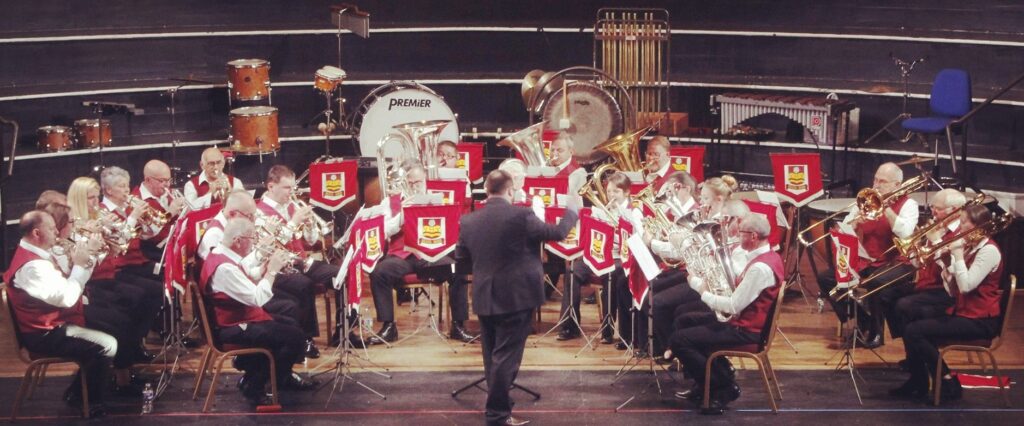
British Brass Bands are limited to specific instruments so they don’t include trumpets or French horns, for example.
The standard instrumentation for a brass band is as follows:
1 soprano cornet (in E♭)
9 cornets (in B♭) – Front row: one principal cornet, three solo cornets
Back row: one repiano cornet, two 2nd cornets, two 3rd cornets
1 flugelhorn (in B♭)
3 tenor horns (in E♭) – solo, 1st and 2nd
2 baritone horns (in B♭) – 1st and 2nd
2 tenor trombones (in B♭) – 1st and 2nd
1 bass trombone (in C)
2 euphoniums (in B♭)
2 E♭ basses
2 B♭ basses
Percussion
The above totals 27–29 players, although in practice a band often has fewer than this.
Standard percussion can include the drum kit, glockenspiel, timpani, tambourine, triangle, or bells.
For a discussion about the differences between B♭ (“B-flat”), E♭ (“E-flat”) and C instruments, see our Notation page.
Cornets

The cornet is usually the leading melodic instrument in the band – it usually gets the ‘tune’. Although it may look similar to a trumpet (which we don’t use) there are some major differences. The cornet has a conical bore, a more compact shape and a deeper mouthpiece which give it a more mellow tone quality. In a full brass band there are 8 – 9 of them but in practice there are usually less.
A full brass band had a Principal Cornet player, similar to the leader of an Orchestra; 3 other Solo (or “front row”) Cornet players; a Soprano Cornet (see above); 2 playing the 2nd Cornet part and 2 playing the 3rd Cornet part, all providing harmonies, plus a Repriano Cornet player, whose role is to fill out the harmony and support the other cornet parts.
Fore more on cornets in a brass band click here.
The Soprano Cornet
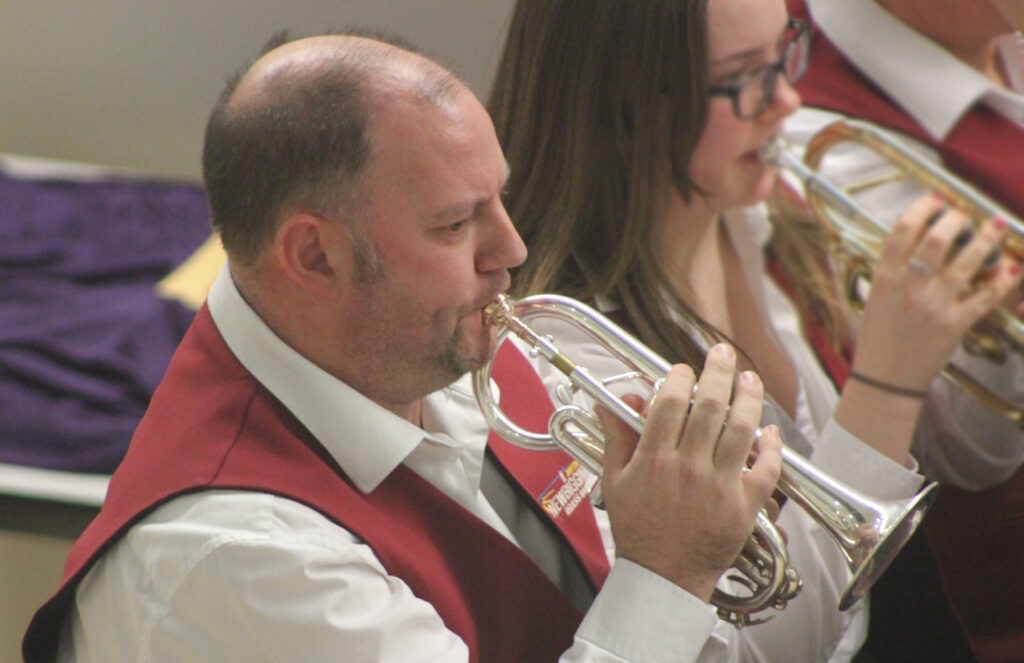
The Soprano Cornet is the highest pitched instrument in the band. It’s very similar to the Cornet, but it’s pitched in E♭. In a brass band there is only one. They can take the role of the leading melodic instrument in the band, play a harmonic support role, or play countermelodic lines.
The Flugelhorn
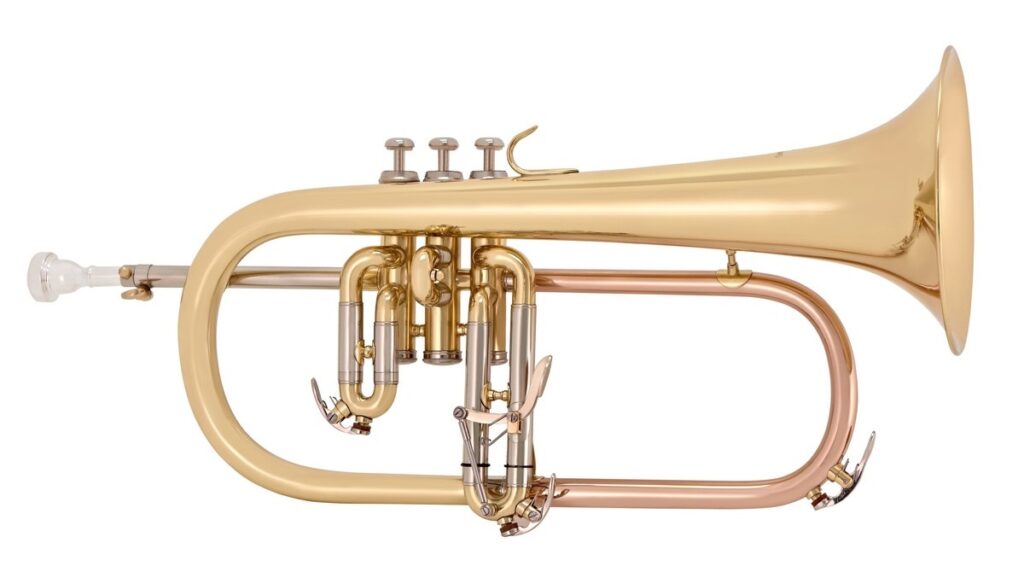
There’s only one flugelhorn in the brass band. It’s is built in the same B♭ pitch as the cornet, but has a much darker and more mellow sound due to it’s shape. It can play solos, play melodic lines with the cornets or take a role with supporting harmony. It’s tone bridges the gap between the lower pitched tenor horns and the brighter cornets.
Tenor Horns
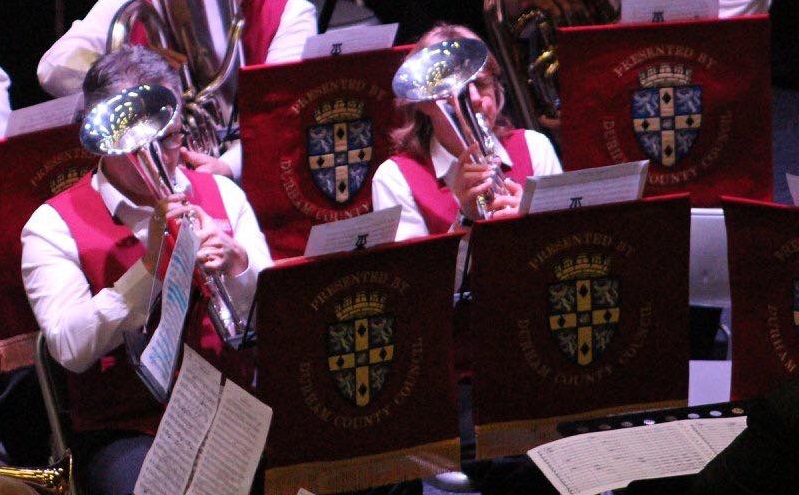
The tenor horn sits in the middle of the band. There are usually three of them and they can play solos / the tune, or accompaniment. They are pitched in E♭. It has a mostly conical bore, much like the higher pitched flugelhorn or the lower pitched baritone horn. It’s the highest pitched instrument in the band that is played upright; they’re designed like this so that the sound can blend before reaching the audience, a quality that is especially useful for accompaniment playing. Many believe that the tenor and baritone horns (see below) are what give a brass band its unique sound quality.
Baritone Horns and Euphoniums

The baritone horn (B♭) is lower pitched than the tenor horn. There are two of them in a brass band. Usually they play accompaniment parts but sometimes they take a melodic role. It is pitched the same as the euphonium but its bore is narrower, meaning it doesn’t sound quite as mellow.
The euphonium is pitched the same as the baritone. The difference is that the euphonium has a larger bore size than the baritone, and the baritone is primarily cylindrical bore, whereas the euphonium is predominantly conical bore. In a standard band there are 2 of them. The name euphonium comes from ancient greek ‘eu’ (good/well) and ‘phone’ (sound) and means ‘beautiful sound’. They can be have melodic or harmonic parts. They’re very popular for solos because of their deep and mellow tone.
The euphonium is actually a small bass or tuba, rather than a horn, but is usually linked closest to the baritone horns in a brass band.
For more on horns in a brass band click here.
Trombones
There are two types of trombone in the band: the tenor trombones and the bass trombone. Both of them use a slide to play a full range of notes.
Tenor trombones in a brass band are treated as transposing instruments in B♭. They are pitched the same as the euphonium and baritone horn. They can be narrow or wide bored and have no valves, although many tenor trombones now incorporate an “F” key to provide a greater range and flexibility of slide positions. Tenor trombones play both melodic and harmonic parts. There are usually two of them in a brass band.

The Bass trombone plays in Concert pitch in C. Its tubing length of 9 feet (2.7 m) is identical to that of the tenor trombone, but it has a wider bore, a larger bell, and a larger mouthpiece. These features generate an overall darker, weightier tone that speaks with a more assured authority in lower registers when compared to the tenor trombone. It has 2 additional lengths of tubing.
Like the soprano cornet, the bass trombone is often used to add “colour” to a brass band with it’s distinctive low, booming and often rasping sound.
The photo shows Jayess Newbiggin Brass Band trombone section. Note that there are actually 2 bass trombones in the picture, but one was used to play a tenor trombone part. The middle one is a tenor trombone with an F key attachment.
For more on trombones in a brass band click here.
Basses
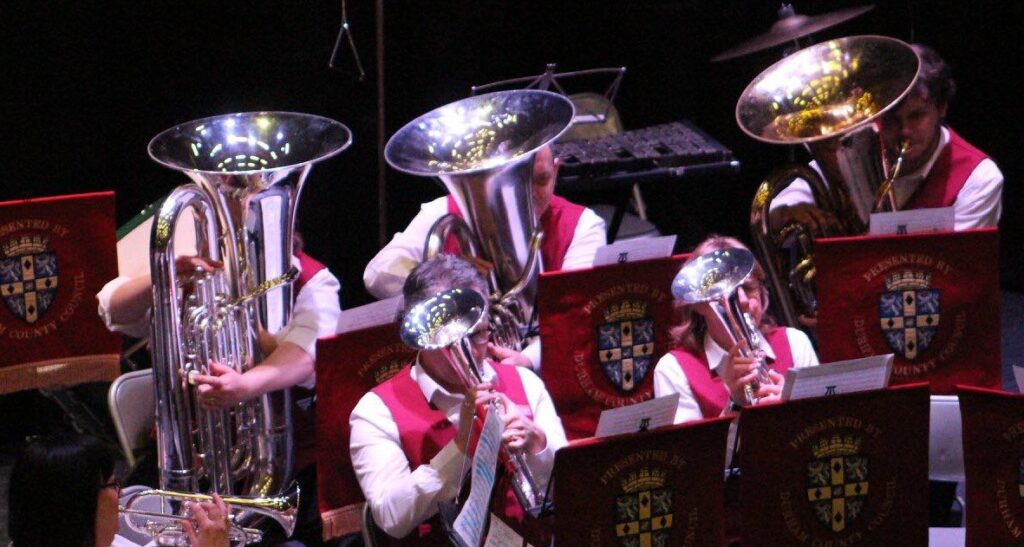
The basses used in brass bands are generally of two types: the E♭ bass and the B♭ bass (sometimes called the BB♭ “double B-flat” bass). Technically, the instrument is a type of tuba, but we call them ‘basses’ by convention for reasons we’ll get to that later! They’re the largest of the brass instruments. The ones used in brass bands follow the upright pattern (similar to that of the euphonium). Most of these basses are constructed with four valves of the piston type.
As in any musical group, the role of the bass instruments in a brass band is to provide a foundation for the rest of the sound. An essential component of all good brass bands is a powerful bass section, which is sometimes felt rather than heard. In the hands of a skilled player, the bass can be an effective melodic instrument, although solo bass passages are rare. The instrument is rarely used as a solo instrument, but some bass solos have been published over the years.
The E♭ bass is the smaller of the two types of bass used in the traditional brass band. It is pitched a fifth lower than the trombone or euphonium, and an octave lower than the tenor E♭ horn. The bass parts are written in treble clef. An E♭ bass playing such a part sounds an octave and a sixth below the written (concert) pitch.
The B♭ bass is the largest and lowest-pitched instrument in the brass band. It is pitched a fourth below the E♭ bass and an octave below the euphonium. The bass parts are written in treble clef. When written in this way, the B♭ bass sounds two octaves and a second below the written (concert) pitch. This two-octave difference between the written and actual sounds is sometimes credited with the common designation of this instrument as the “double” B♭ bass.
Why don’t we call them tubas?
The tubas used in symphony orchestras are pitched in F or C. They’re constructed with rotary rather than piston valves. And since orchestral parts are written in bass clef, the tuba part is read at concert pitch.
For more on basses in a brass band click here.
Percussion
A percussion instrument an instrument sounded by being struck or scraped by a beater, like a drum, a cymbal, or a xylophone.
Pitched percussion, like the glockenspiel, vibraphone or marimba are notated in concert pitch, but unpitched percussion, such as the drum kit is different. It’s notated with a specific percussion clef – see our Notation page.
For more on percussion in a brass band click here.